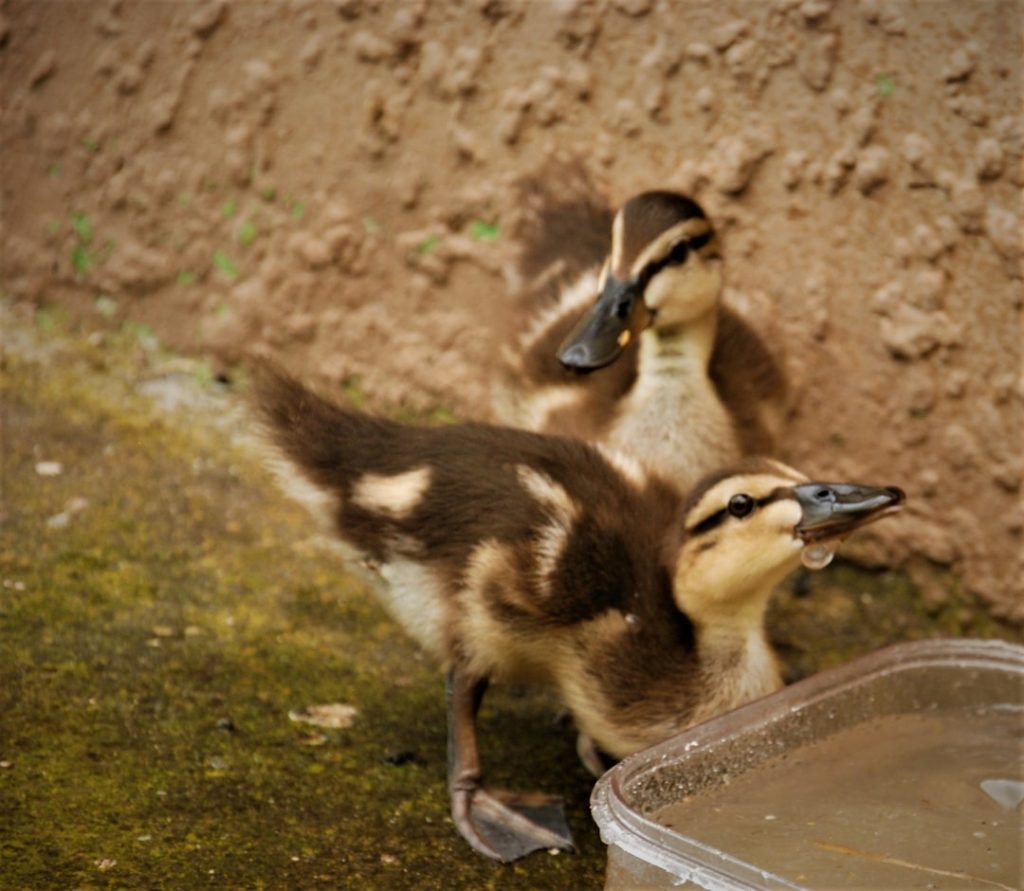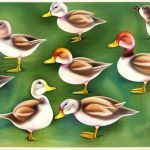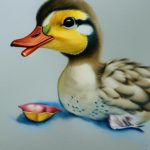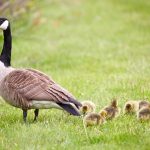Baby ducks are undeniably one of the cutest creatures on the planet, and capturing their adorable antics in photographs is a delightful pastime for many animal lovers. Whether they are splashing in a pond, waddling on land, or cuddling with their siblings, baby duck pictures never fail to bring a smile to people’s faces. These fluffy little creatures are a joy to behold, and their endearing features make them perfect subjects for photography.
When it comes to baby duck pictures, there is no shortage of heartwarming moments to capture. From their soft downy feathers to their tiny webbed feet, every aspect of a baby duck’s appearance is utterly charming. Their playful nature and curious expressions also make for captivating photographs that can brighten anyone’s day. Whether you’re an amateur photographer or a seasoned professional, snapping pictures of baby ducks is a rewarding experience that allows you to appreciate the beauty of nature in its purest form.
In the world of social media and digital photography, sharing baby duck pictures has become a popular way for people to spread joy and positivity online. These delightful images often go viral, garnering thousands of likes and shares as they bring happiness to people around the world. Whether it’s a close-up shot of a fluffy duckling or a group of ducklings following their mother in a line, these pictures have the power to uplift spirits and remind us of the simple pleasures in life. So, whether you’re an avid photographer or simply a fan of adorable animals, capturing the charm of baby ducks in pictures is an activity that is sure to bring joy to both the photographer and the viewer.
Table of Contents
- 1 Exploring Different Breeds of Baby Ducks
- 2 Understanding the Characteristics of Different Baby Duck Breeds
- 3 Tips for Taking Stunning Baby Duck Pictures
- 4 Capturing the Cuteness of Baby Ducklings in Photos
- 5 Baby Duck Breeds: A Guide for Duck Enthusiasts
- 6 Showcasing the Diversity of Baby Duck Breeds through Photography
- 7 FAQs
Key Takeaways
- Baby duck pictures are adorable and captivating, showcasing the cuteness of these tiny creatures.
- There are various breeds of baby ducks, each with unique characteristics and traits that make them special.
- Understanding the characteristics of different baby duck breeds can help in appreciating their diversity and beauty.
- Tips for taking stunning baby duck pictures include getting down to their level, using natural light, and capturing their playful moments.
- Capturing the cuteness of baby ducklings in photos requires patience, creativity, and a love for these adorable creatures.
Exploring Different Breeds of Baby Ducks
Baby ducks come in a wide variety of breeds, each with its own unique characteristics and traits. From the popular Pekin duck to the colorful Mallard, there is a diverse range of baby duck breeds to explore and appreciate. Whether you’re interested in raising ducks as pets or simply want to learn more about these fascinating creatures, understanding the different breeds of baby ducks is an enriching experience that allows you to delve into the world of avian diversity.
One of the most well-known baby duck breeds is the Pekin duck, which is prized for its white plumage and friendly disposition. Pekin ducklings are particularly adorable with their bright yellow fluff and orange bills, making them a popular choice for those looking to raise ducks as pets. Another popular breed is the Mallard, known for its striking iridescent green head and vibrant plumage. Mallard ducklings are a sight to behold with their distinctive markings and lively personalities, making them a favorite subject for photographers and nature enthusiasts alike.
In addition to the Pekin and Mallard, there are many other baby duck breeds to discover, each with its own unique characteristics and charm. From the regal Muscovy duck to the elegant Rouen duck, there is a breed of baby duck to suit every preference and interest. Whether you’re drawn to the striking colors of the Indian Runner duck or the endearing appearance of the Khaki Campbell, exploring the diverse world of baby duck breeds is a fascinating journey that allows you to appreciate the beauty and variety of these delightful creatures.
Understanding the Characteristics of Different Baby Duck Breeds
Each breed of baby duck has its own distinct characteristics that set it apart from others, making them fascinating subjects for observation and photography. Understanding the traits and behaviors of different baby duck breeds allows you to develop a deeper appreciation for these charming creatures and gain insight into their unique qualities.
The Pekin duck, for example, is known for its friendly and sociable nature, making it an ideal choice for those looking to raise ducks as pets. Pekin ducklings are also fast growers, reaching full size in just a few months, which makes them popular among those who raise ducks for meat production. On the other hand, the Mallard is a wild duck species that exhibits a more independent and cautious demeanor. Mallard ducklings are known for their agility and adaptability, traits that have allowed them to thrive in various habitats around the world.
Other baby duck breeds, such as the Muscovy and Indian Runner, also have their own distinctive characteristics that make them stand out. Muscovy ducklings are known for their unique appearance, with red wattles around their bills and striking black and white plumage. They are also excellent fliers and prefer to roost in trees, unlike other domestic duck breeds. Indian Runner ducklings, on the other hand, are known for their upright posture and distinctive walking style, which sets them apart from other breeds. Understanding these characteristics allows you to appreciate the diversity of baby duck breeds and gain insight into their individual traits and behaviors.
Tips for Taking Stunning Baby Duck Pictures
Capturing stunning baby duck pictures requires patience, creativity, and an understanding of these delightful creatures’ behavior. Whether you’re photographing them in their natural habitat or in a controlled environment, there are several tips and techniques that can help you take captivating pictures of baby ducks that showcase their charm and beauty.
One important tip for taking stunning baby duck pictures is to get down to their level. By crouching or lying on the ground, you can capture eye-level shots that provide a unique perspective and allow you to showcase the adorable features of baby ducks up close. This technique also helps create an intimate connection between the viewer and the subject, making for more engaging and impactful photographs.
Another tip is to observe their behavior and anticipate their movements. Baby ducks are active and curious creatures, so being patient and observant can help you capture candid moments that reflect their playful nature. Whether they are splashing in water, preening their feathers, or interacting with each other, capturing these spontaneous moments can result in charming and endearing photographs that highlight the essence of baby ducks.
In addition to getting down to their level and observing their behavior, using natural light can also enhance your baby duck pictures. Early morning or late afternoon light provides a warm and soft glow that can accentuate the fluffy feathers and vibrant colors of baby ducks, creating a visually appealing effect in your photographs. By paying attention to these tips and techniques, you can take stunning baby duck pictures that capture the cuteness and charm of these delightful creatures in all their glory.
Capturing the Cuteness of Baby Ducklings in Photos
Capturing the cuteness of baby ducklings in photos requires a keen eye for detail and an understanding of their endearing features. From their fluffy downy feathers to their expressive eyes, there are many elements that make baby ducklings irresistibly adorable subjects for photography. By focusing on these charming attributes and using creative techniques, you can capture captivating photos that showcase the cuteness of baby ducklings in all its glory.
One effective way to capture the cuteness of baby ducklings in photos is to focus on their expressive eyes. Ducklings have large, bright eyes that exude innocence and curiosity, making them captivating subjects for close-up shots. By zooming in on their eyes and capturing their soulful gaze, you can create intimate and heartwarming photographs that highlight the endearing nature of baby ducklings.
Another technique for capturing the cuteness of baby ducklings in photos is to emphasize their fluffy downy feathers. Ducklings are covered in soft down feathers that give them a cuddly and adorable appearance. By using shallow depth of field and focusing on their feathers while blurring the background, you can create dreamy and enchanting images that accentuate the fluffiness and charm of baby ducklings.
In addition to focusing on their eyes and feathers, capturing candid moments of baby ducklings engaging in playful activities can also showcase their cuteness in photos. Whether they are waddling on land, splashing in water, or cuddling with their siblings, capturing these spontaneous moments can result in heartwarming images that reflect the joyful spirit of baby ducklings. By using these techniques and focusing on their endearing features, you can capture the cuteness of baby ducklings in photos that evoke warmth and delight in viewers.
Baby Duck Breeds: A Guide for Duck Enthusiasts
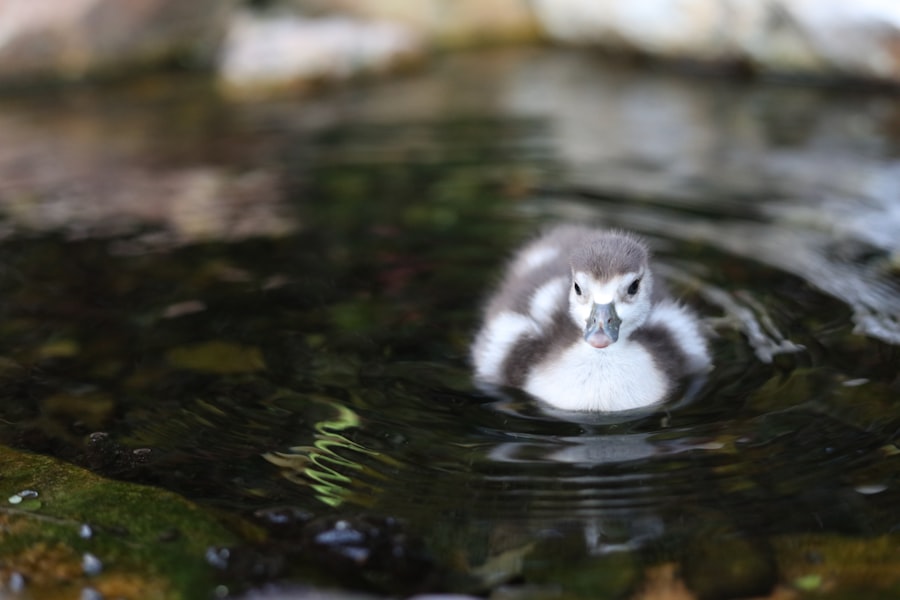
For duck enthusiasts, learning about different baby duck breeds is an enriching experience that allows them to appreciate the diversity and beauty of these delightful creatures. From domestic breeds like Pekin and Muscovy to wild species like Mallard and Wood Duck, there is a wide range of baby duck breeds to explore and admire. Understanding their unique characteristics, behaviors, and care requirements is essential for anyone interested in raising ducks as pets or simply wanting to expand their knowledge about these charming birds.
One popular domestic breed is the Pekin duck, known for its friendly disposition and excellent egg-laying capabilities. Pekin ducks are also prized for their fast growth rate, making them a popular choice for meat production as well. Another domestic breed is the Muscovy duck, which is recognized for its distinctive appearance with red wattles around its bill and striking black and white plumage. Muscovy ducks are excellent fliers and prefer roosting in trees, making them unique among domestic duck breeds.
In addition to domestic breeds, there are also wild species like Mallard and Wood Duck that captivate duck enthusiasts with their striking plumage and fascinating behaviors. Mallards are known for their iridescent green heads and vibrant plumage, while Wood Ducks are admired for their colorful markings and preference for nesting in tree cavities near water bodies. Learning about these different baby duck breeds allows enthusiasts to gain insight into their individual traits and characteristics, fostering a deeper appreciation for the diversity of ducks in the avian world.
Showcasing the Diversity of Baby Duck Breeds through Photography
Photography provides a wonderful platform for showcasing the diversity of baby duck breeds, allowing enthusiasts to capture the unique features and behaviors of these charming birds in stunning images. Whether it’s capturing the vibrant plumage of wild species like Mallard and Wood Duck or highlighting the endearing qualities of domestic breeds like Pekin and Muscovy, photography allows enthusiasts to celebrate the beauty and diversity of baby duck breeds through visual storytelling.
One way to showcase the diversity of baby duck breeds through photography is by capturing close-up shots that highlight their distinctive features. By focusing on details such as plumage patterns, bill shapes, and eye colors, photographers can create compelling images that showcase the individual traits of different duck breeds. These close-up shots provide viewers with an up-close look at the unique characteristics that make each breed special, fostering a deeper understanding and appreciation for the diversity of baby ducks.
Another approach to showcasing the diversity of baby duck breeds through photography is by capturing them in their natural habitats or specific environments that reflect their behaviors. Whether it’s photographing Mallards swimming gracefully in a pond or Pekin ducks waddling on land, capturing these scenes allows photographers to convey the distinct behaviors and preferences of different duck breeds through visual storytelling. By showcasing these diverse environments and behaviors through photography, enthusiasts can offer viewers a glimpse into the fascinating world of baby duck breeds.
In addition to close-up shots and environmental portraits, capturing interactions between different baby duck breeds can also showcase their diversity through photography. Whether it’s capturing Mallards socializing with other waterfowl species or domestic ducks interacting with each other in a farm setting, photographing these interactions provides viewers with insights into the social dynamics and relationships between different duck breeds. By using photography as a tool for storytelling, enthusiasts can celebrate the diversity of baby duck breeds and share their beauty with audiences around the world.
In conclusion, baby ducks are undeniably adorable creatures that captivate people with their charm and beauty. Whether it’s through photography or simply observing them in nature, learning about different baby duck breeds allows enthusiasts to gain insight into their unique characteristics and behaviors while fostering a deeper appreciation for these delightful birds. By capturing stunning images that showcase the cuteness and diversity of baby ducks through photography, enthusiasts can share their passion for these charming creatures with others while celebrating the beauty of nature in all its forms.
If you’re captivated by adorable baby duck pictures and interested in learning more about different duck breeds, you’ll love the article “What Should You Feed Ducks” on PoultryWizard.com. This comprehensive guide provides valuable insights into the dietary needs of ducks, helping you ensure that your feathered friends are well-nourished and healthy. Whether you’re a seasoned duck owner or considering adding ducks to your flock, this article offers essential information to keep your ducks thriving. Check it out here.
FAQs
What are some popular breeds of baby ducks?
Some popular breeds of baby ducks include Pekin, Mallard, Khaki Campbell, Rouen, and Muscovy.
What do baby ducks look like?
Baby ducks, also known as ducklings, are typically fluffy and yellow in color. They have a small beak and webbed feet.
At what age do baby ducks start to feather out?
Baby ducks start to feather out at around 2-3 weeks of age. Their downy feathers are gradually replaced by adult feathers.
How long does it take for baby ducks to mature into adults?
It takes about 2-3 months for baby ducks to mature into adults, depending on the breed.
Are there any specific care requirements for baby ducks?
Baby ducks require a warm and safe environment, proper nutrition, access to water for swimming and drinking, and protection from predators. It’s important to provide them with a balanced diet and clean living conditions.
Meet Walter, the feathered-friend fanatic of Florida! Nestled in the sunshine state, Walter struts through life with his feathered companions, clucking his way to happiness. With a coop that’s fancier than a five-star hotel, he’s the Don Juan of the chicken world. When he’s not teaching his hens to do the cha-cha, you’ll find him in a heated debate with his prized rooster, Sir Clucks-a-Lot. Walter’s poultry passion is no yolk; he’s the sunny-side-up guy you never knew you needed in your flock of friends!

